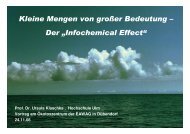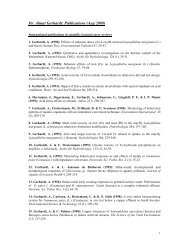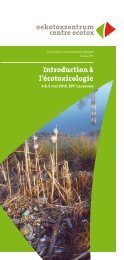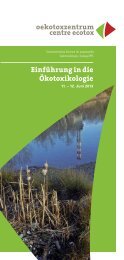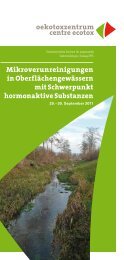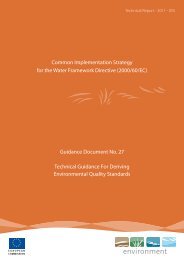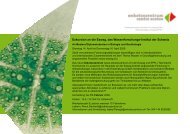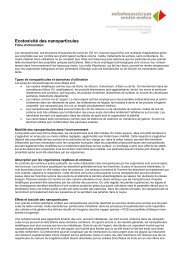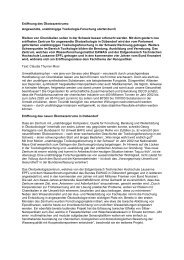Evaluation of Bioassays and Wastewater Quality ... - Oekotoxzentrum
Evaluation of Bioassays and Wastewater Quality ... - Oekotoxzentrum
Evaluation of Bioassays and Wastewater Quality ... - Oekotoxzentrum
Create successful ePaper yourself
Turn your PDF publications into a flip-book with our unique Google optimized e-Paper software.
Compared with chemical analytics, results from the combined algae assay indicated higher<br />
elimination efficiency for herbicides acting as photosystem II inhibitors. This may be explained by<br />
the presence <strong>of</strong> additional herbicides with this mode <strong>of</strong> action, which were not included in the<br />
analytical measurements.<br />
4.6. Mutagenicity <strong>and</strong> genotoxicity<br />
No mutagenicity (Ames assay, strains TA98 <strong>and</strong> TA100) (Ames et al., 1975) (ISO 16240, 2005)<br />
<strong>and</strong> no genotoxicity (micronucleus assay, with <strong>and</strong> without S9 activation) (Reifferscheid et al.,<br />
2008) (ISO 21427-2, 2006) were detected. In the umuC assay (ISO 13829, 2000, with S9<br />
activation), genotoxic effects in the influent <strong>and</strong> after biological treatment have been detected<br />
only in highly enriched samples (EN ≥14.8 fold, LF ≥ 37 fold). In one MC slight genotoxic effects<br />
in PAC-UF (≥ 74 fold enrichment) were detected.<br />
Overall no change in genotoxicity <strong>and</strong> mutagenicity was measured following advanced<br />
treatments. This was observed in other studies as well for PAC treatment (e.g. Stalter et al.,<br />
2010a) <strong>and</strong> ozonation (e.g. Mišík et al., 2011; Petala et al., 2006; Reungoat et al., 2010;<br />
Takanashi et al., 2002). In selected studies genotoxic effects were detected after ozonation (e.g.<br />
Stalter et al., 2010a); however they were eliminated by subsequent s<strong>and</strong> filtration.<br />
We conclude that there is no evidence <strong>of</strong> higher toxicity due to the formation <strong>of</strong> stable ozonation<br />
by-products. It is, however, possible that the tests used were not sufficiently sensitive to these<br />
compounds. Because formation <strong>of</strong> reactive ozonation by-products cannot be excluded based on<br />
our results, the installation <strong>of</strong> a final filtration step with biological activity is recommended.<br />
4.7. Conclusions from the performance review<br />
A clear reduction <strong>of</strong> wastewater toxicity due to ozonation <strong>and</strong> powdered activated carbon<br />
treatment followed by ultrafiltration was demonstrated with most in vitro bioassays <strong>and</strong> with one<br />
in vivo bioassay (Fish Early Life Stage test with O. mykiss). The other applied bioassays showed<br />
either no toxicity or no change in toxicity in the course <strong>of</strong> wastewater treatment. The overall<br />
elimination efficiency for most <strong>of</strong> the assessed specific substance classes was more than 80%.<br />
However, there were differences in toxicity for different sampling time points, which presumably<br />
resulted from differences in wastewater composition. There was no evidence <strong>of</strong> increased<br />
toxicity due to a constant formation <strong>of</strong> ozonation by-products. Using in vivo bioassays performed<br />
in the lab, a slight toxicity <strong>of</strong> raw wastewater was detected. This was mostly eliminated after<br />
biological treatment. The toxicity <strong>of</strong> the wastewater observed in those in vivo assays was<br />
generally low.<br />
In general, the application <strong>of</strong> bioassays for a performance assessment <strong>of</strong> advanced wastewater<br />
treatment technologies proved to be relevant <strong>and</strong> useful, as shown in this pilot study as well as in<br />
the previous pilot study at the WWTP Wüeri in Regensdorf (Abegglen et al., 2009).<br />
However, it is important to note, that a single general bioassay for the overall assessment <strong>of</strong> the<br />
toxicity <strong>of</strong> a wastewater sample does not exist. No single bioassay covers the whole range <strong>of</strong><br />
different toxic effects in wastewater. Therefore, a set <strong>of</strong> bioassays has to be used to evaluate the<br />
performance <strong>of</strong> wastewater treatment plants.<br />
Swiss Centre for Applied Ecotoxicology, Eawag/EPFL · Überl<strong>and</strong>strasse 133 · CH-8600 Dübendorf<br />
www.oekotoxzentrum.ch<br />
28



